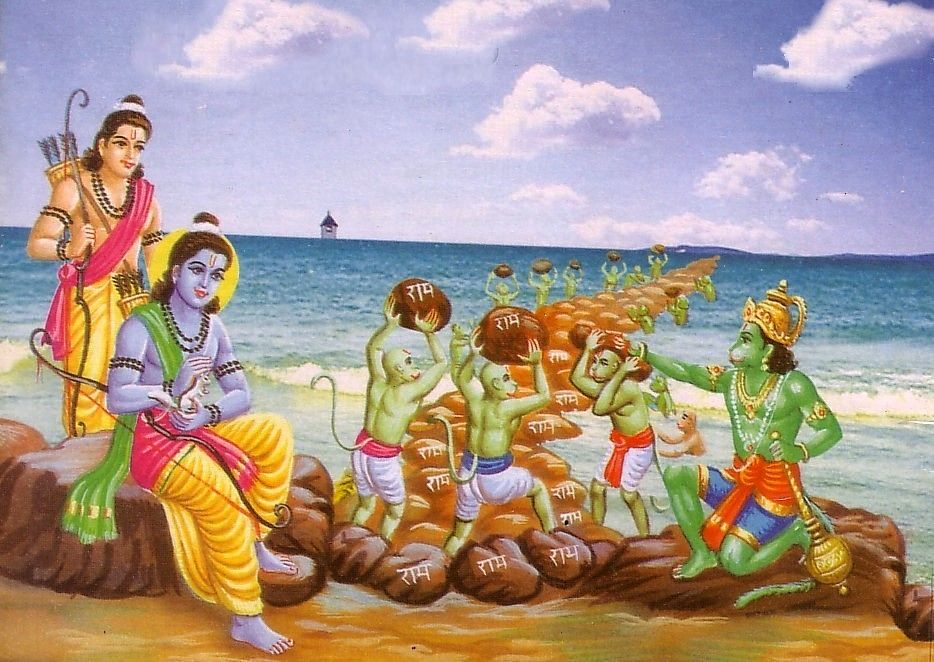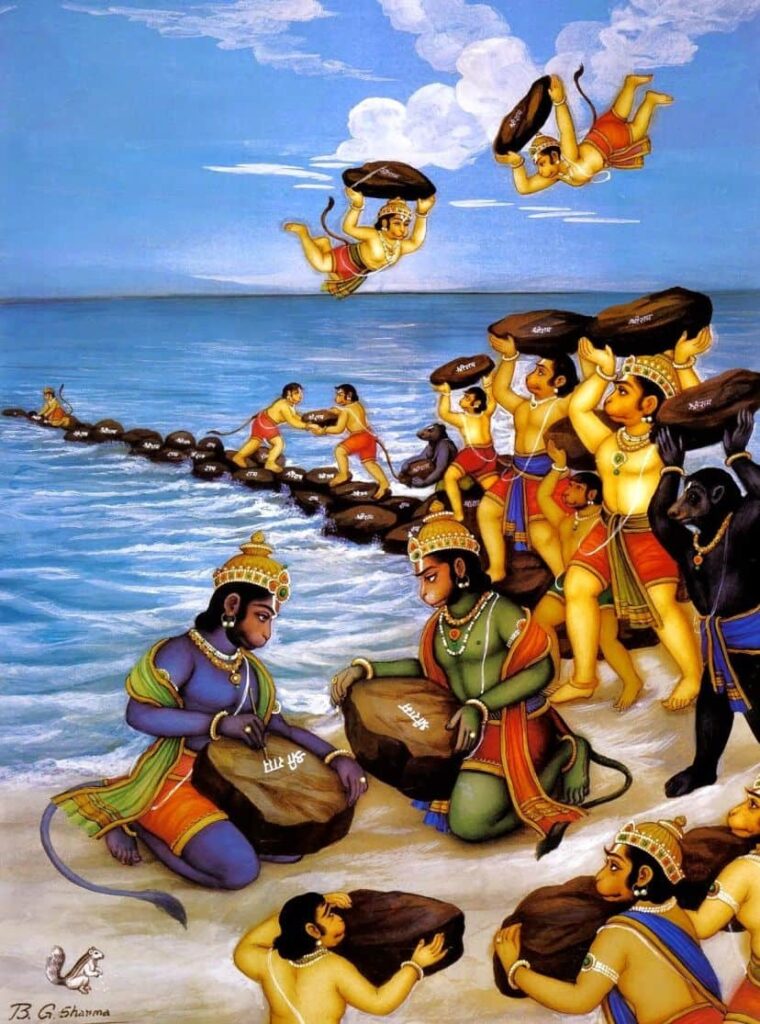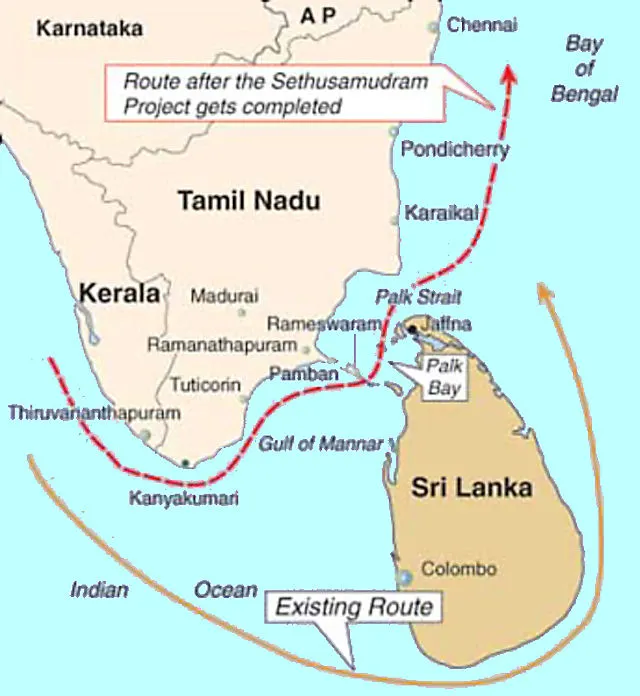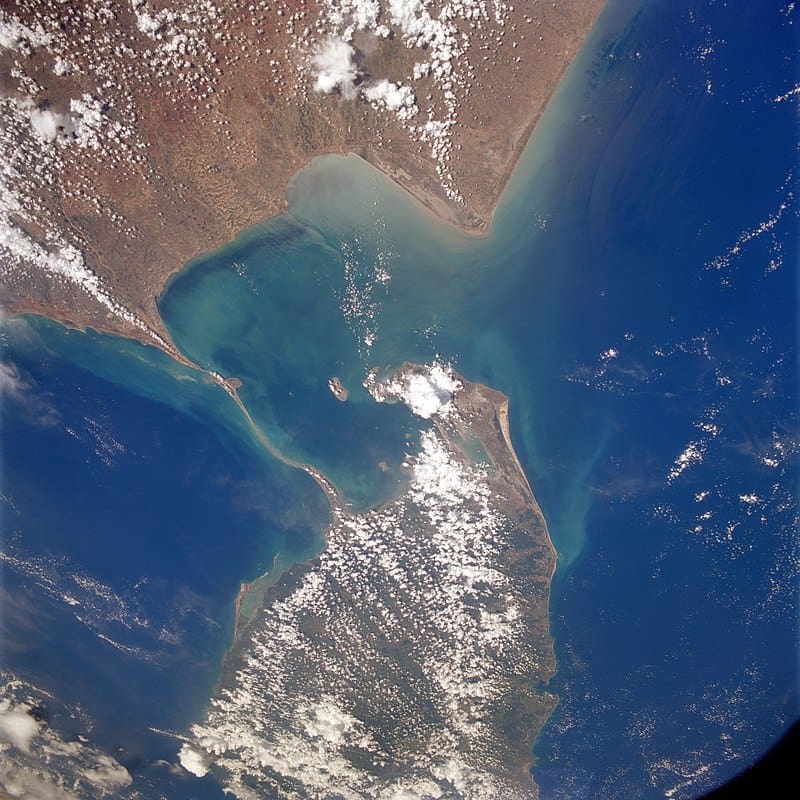Ram Setu Pul, also known as Adam’s Bridge, is a bridge-like structure connecting India’s southern tip to Sri Lanka’s northwestern coast. It has been a subject of debate, myth, and controversy for centuries, with people questioning its existence and origin.

Profiling Ram Setu Pul
| Common Name | Rama Setu, Ramsethu, Nala Setu, Setu Banda, Adam’s Bridge |
| Length | 48 km (30mi) |
| Made from | Limestone Shoals |
| Located | Between Pamban Island or Rameshwar Island (southeastern coast of Tamil Nadu) and Mannar Island in Sri Lanka |
| Extension | Separates Gulf of Myanmar from Palk Strait |
| Formation | 103 small patch reefs (source) |
| Submerge | 1 meter below sea level |
| Architect | Nala (Valmiki Narayana), Naturally formed (Modern Scientists) |
Ram Setu in Ramayana
मममातुर्वरोदत्तोमन्दरेविश्वकर्मणा ।
Valmiki Ramayana, Yudha kanda 6.22.49-51
औरसस्तस्यपुत्रोऽहंसदृशोविश्वकर्मणा ।।
नचाप्यहमनुक्तोवःप्रब्रूयामात्मनोगुणान् ।
समर्थश्चाप्यहंसेतुंकर्तुंवैवरुणालये ।।
स्मारितोऽस्म्यहमेतेनतत्त्वमहामहोदधिः ।
काममद्वैवबध्नन्तुसेतुंवानरपुङ्गवाः ।।
On the Mandara mountain, Vishwakarma gave a boon to my mother. I am Vishwakarma’s own son, and I am like him at work because of that reason. I have put in my memory all about the ocean. I am aware of the truth of the ocean. I could not speak of my qualities unless questioned. I can build a bridge over the abode of Varuna. Right away let the Vanara leaders get the material required for building the bridge. This is what Nala (son of Vishwakarma deva) said to Lord Rama before bestowing his mighty architectural skill.
After Lord Hanuman conveyed the message of Devi Sita to Lord Rama, the whole Rama Sena (composed of Vanara Sena) was set on a journey to Lanka. On the way, there was a great seashore (Sagara) which was almost impossible to cross. Lord Rama, out of anger, was ready to dry up the whole ocean to the underworld using his arrow.
The scared sea of gods appeared and asked Lord Ram not to dry up the river but instead build a bridge over the ocean with the help of Nala. After assuring words from Nala, Lord Rama directed Vanara Sena to spring into the forest to search for materials to build a bridge. Roots, stones, trees, everything Vanara Sena got, were used in building this mighty bridge.

Nala, with the assistance of his twin brother Nila, started building this bridge of archeological magnificence. The bridge was being made at full pace. On the first day, they built 14 yojanas, second 20 yojanas, 21 third, 22 fourth, and 23 in the fifth. The bridge was 10 yojanas in width and hundred yojanas in length.
The bridge was inspected by many gods and Gandarvas,
विशालस्सुकृतश्रशीमान् सुभूमिस्सुसमाहितः ।
अशोभतमहान् सेतुस्सीमन्तइवसागरे ।।That huge bridge was well built, magnificent, evenly built, and extensive and looked charming like the partition in a woman’s hair.
Valmiki Ramayana, Yudha kanda 6.22.78
The Vanara Sena out of joy at what they have achieved and excitement about rescuing Sita Maa, crossed the mighty bridge. That bridge is Ram Setu, or to be more specific Nala Setu, the bridge used by Lord Rama to reach Lanka (present-day Sri Lanka).
Concept Behind Naming Adam’s Bridge
After the first human on Earth (as per the bible) fell from the Garden of Edens (Bibalic paradise), he crossed over to the Indian peninsula using Nala Setu. There is a mountain peak named Adam’s Peak in Sri Lanka where Adam is believed to be first landed (Islamic belief). Since it was crossed by Adam, it is considered as Adam’s Bridge.
Modern History of Ram Setu
- Adam’s Bridge has served as a land connection between India and Sri Lanka during periods of lowered sea level over the past 100,000 years.
- The temporary connection between India and Sri Lanka through Adam’s Bridge helps explain how certain species of birds evolved differently from their ancestors in different regions of India. (source)
- Major James Rennell suggested a navigable passage could be maintained by dredging the strait of Ramisseram, but his proposal was not noticed until 60 years later.
- In 1823, Sir Arthur Cotton was assigned to survey the Pamban Channel and suggested it could be dredged to enable the passage of ships.
- Major Sim directed the blasting and removal of some rocks in 1828, and a more detailed marine survey was undertaken in 1837, but efforts in the 19th century did not succeed in keeping the passage navigable for any vessels except those with a light draft.
- The Sri Lankan Tourism Development Authority included the Ram Setu as one of the points on its “Ramayana Trail” in 2007 to promote religious tourism from Hindu pilgrims in India, but some Sri Lankan historians criticized it as a “gross distortion of Sri Lankan history”. (source)
Controversy over Ram Setu
The controversy surrounding Ram Setu began in 2005 when the Indian government proposed to construct a shipping canal that would cut through the bridge, thereby reducing the travel time between India and Sri Lanka.
This proposal was met with opposition from various groups, including religious organizations, environmentalists, and political parties. The project was named the Sethusamudram shipping canal project which was proposed back in 1956.

Opponents of the project argued that the construction of the canal would destroy Ram Setu, which is considered a religious symbol by many Hindus. They argued that the bridge is a cultural heritage site and has great religious significance, as it is believed to have been built by Lord Rama to rescue his wife Sita from the demon king Ravana in Sri Lanka.
Environmentalists also raised concerns about the impact of the project on the fragile marine ecosystem in the region. The construction of the canal was expected to lead to massive dredging and reclamation activities, which would have a devastating impact on the marine biodiversity and the livelihoods of fishermen in the area.
The controversy intensified when a satellite image of the bridge, released by NASA, showed a chain of sandbanks that resembled a man-made bridge. This led to speculation that the bridge was not a natural formation but was built by humans in ancient times.

However, scientists and geologists have argued that the bridge is a natural formation and is made up of sand and sediment that has accumulated over millions of years. They have also pointed out that the sandbanks are constantly shifting due to ocean currents and tides.
Despite the controversy, the Indian government went ahead with the project and submitted an affidavit to the Supreme Court stating that Ram Setu is a natural formation and has no religious or cultural significance. However, the government later withdrew the affidavit after facing protests and opposition from various groups.
In 2019, the Indian government declared Ram Setu a national monument and a site of cultural and historical importance. The move was welcomed by many who saw it as a recognition of the bridge’s cultural and religious significance.
Ram Setu Pul, also known as Adam’s Bridge, is a structure of great significance in Hindu dharma and Indian history. While the scientific evidence suggests that it is a natural formation, the historical and religious significance of the structure cannot be denied.
The ongoing debate surrounding its preservation highlights the conflict between science and faith and the importance of respecting cultural and religious sentiments. Whether Ram Setu Pul is a man-made or natural structure, it deserves to be preserved as a national heritage site for generations to come.
